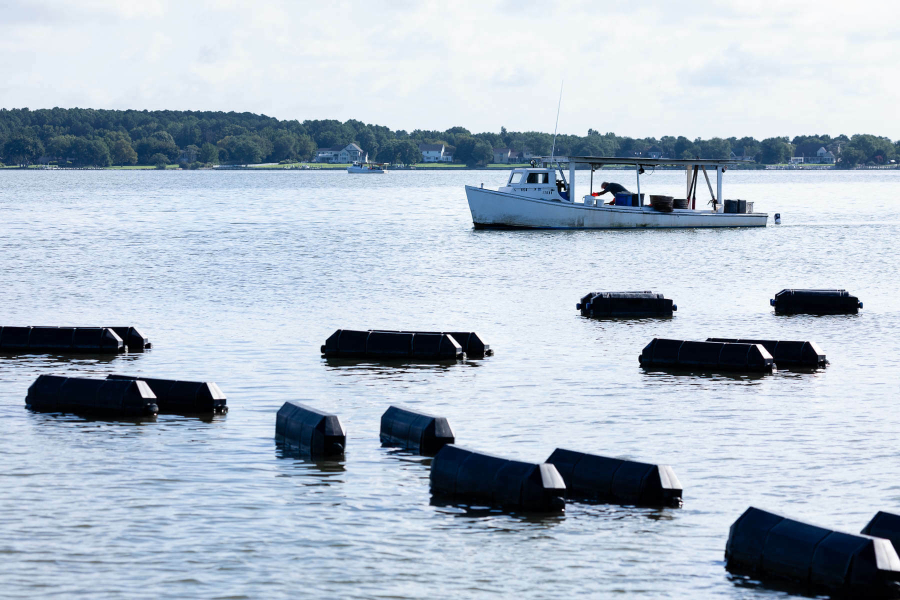Bay’s dead zone is predicted to be 13% smaller this summer

The weather plays an extremely large role in predicting the size and duration of the annual dead zone. For the third year in a row, researchers are predicting the Chesapeake Bay will experience a smaller dead zone than the long-term average (1985-2021). Experts from the University of Maryland Center for Environmental Science, University of Michigan and U.S. Geological Survey believe this is due to the below-average amount of water that entered the Bay this past spring from the major tributaries in the watershed.
Harmful nutrients enter the Chesapeake in larger quantities when we experience a wetter spring. Water flowing into the Bay’s tributaries from surrounding landscapes can bring pollutants along with them, such as fertilizers, pet waste, litter and toxic contaminants. Heavy rainfall can also cause erosion, particularly in areas where grasses and trees have been removed.
The Chesapeake Bay Program recently announced that actions taken by the watershed jurisdictions—Delaware, District of Columbia, Maryland, New York, Pennsylvania, Virginia and West Virginia—to lower nitrogen, phosphorus and sediment pollution were successful in reducing pollutants flowing into the Bay in 2021. Fewer nutrients (nitrogen and phosphorus) and sediments flowing into the Chesapeake also are a factor in the smaller size forecasted for the annual dead zone.
When large amounts of nutrients flow into the Chesapeake Bay, they cause algae blooms. As the blooms begin to die off and decompose, they remove oxygen from the water around them faster than it can be replenished, causing what is referred to as hypoxic conditions. Hypoxic—or low-oxygen—conditions impact the plant and animal life in the area, which is why it is referred to as a dead zone.
In addition to rainfall, wind is responsible for how large and how long the dead zone will last. Wind is helpful in stirring up surface waters, bringing oxygen to the lower depths of the Bay in order to support marine life. Typically, warmer, lighter and less-salty water layers on top of heavier, colder, saltier waters. When there are weak winds, it stops these layers from mixing—a process called stratification—and keeps oxygen from reaching the marine life at the bottom of the Bay.
The plants and animals that live in the Bay also face threats from warmer water temperatures. Higher temperatures contribute to the stratification of the water, which does not allow oxygen to reach the marine critters below the surface that depend on it for survival. This is one critical way in how climate change is contributing to the dead zone. Experts determined that cooler temperatures in May 2022 helped stave off the dead zone. Where it normally starts in mid-to-late May, it didn’t show up this year until early June.
Our experts produce this forecast each year using a model developed by the University of Michigan. The data and information that goes into this model comes from the Chesapeake Bay Monitoring Program—a Bay-wide cooperative effort involving watershed jurisdictions, several federal agencies, 10 academic institutions and over 30 scientists. The U.S. Geological Survey monitors nitrogen pollution and water flows on nine major rivers in the watershed—Appomattox, Choptank, James, Mattaponi, Pamunkey, Patuxent, Potomac, Rappahannock and Susquehanna—accounting for 78% of the watershed. The remaining 22% comes from pollution reported from wastewater treatment plants.
A Bay-wide assessment of the 2022 dead zone will be available this fall. However, you can get daily, real-time estimates of how much hypoxia is found in the Chesapeake by visiting the Eyes on the Bay website for Maryland or the Virginia Estuarine and Coastal Observing System (VECOS) website for Virginia.

Comments
I realize that a lot of people are working hard on behalf of The Bay. At the same time I really detest these "good news" headlines about things are looking rosy. They're not.
Yesterday my grandson and.I were fishing in a rowboat on Rhode RIver. A commercial lawn company spent the better part of an hour putting unneeded fertilizer on a.large lot that sloped steeply and directly into the river. The homeowner's car has Save The Bay tags. We need to connect the dots here, people.
The home across the street from me was recently bulldozed and replaced with a 4,700 square foot monstrosity. Trees removed. Asphalt driveway paved and expanded. All in the "critical area".
A dead zone is a dead zone. "Dead" as in D.E.A.D. How's about we skip the feel good headlines and keep our eye on the ball?
Thank you!
Your comment has been received. Before it can be published, the comment will be reviewed by our team to ensure it adheres with our rules of engagement.
Back to recent stories